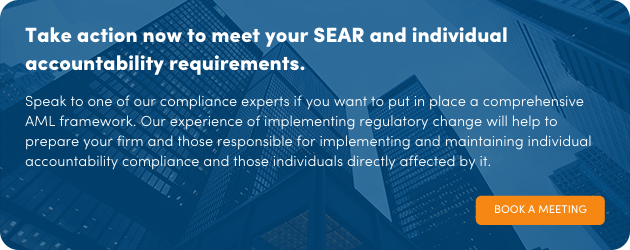Time To Get Serious About SEAR Responsibilities...
Enhanced Individual Accountability
Individual accountability has been a focus for the Central Bank since the global financial crisis. It has been a decade since the Fitness and Probity (F&P) Regime was introduced to ensure that individuals who hold certain positions in regulated firms are committed to high standards of competence, integrity, and honesty. More recently, the introduction of an enhanced Individual Accountability Framework (IAF) for individuals, particularly senior individuals, working in regulated financial services firms in Ireland.
The four key components of this proposed framework are:
Regulatory Determination and Responsibility Map
Most legal advice is currently encouraging organisations to map responsibilities and roles to specific regulatory obligations. But, there is one regulatory area that should be exercising the minds of senior executives and board directors right now. It is basic but critical. Regulated businesses must ensure they have proper processes in place to ensure a business is not facilitating the movement of money for criminal purposes.
Specifically, regulatory concerns are focused on Anti-Money Laundering (AML) and Counter-Terrorism Financing (CTF) risks. On an almost daily basis, we are being reminded that domestic and international regulators are determined to reduce the massive $2 trillion of estimated criminal proceeds laundered through the global financial system each year. Recent stories in the media would suggest regulatory determination is moving up a gear:
- US: FinCen renewed its Geographic Targeting Orders (GTOs) that require US insurance companies to identify the natural persons behind shell companies used in all-cash purchases of residential real estate.
- EU: Finance Commissioner, Mairead McGuinness, is promising a new AML legislative package that will ban cash transactions of more than €10,000 in the EU. In a separate development, the European Banking Authority is setting up a centralised database to name and shame financial institutions which have weak AML controls. First on the list might be….
- Germany: Regulator BaFin, still nursing its wounds from the Wirecard debacle, has just taken the highly unusual step of appointing a monitor to observe the implementation of proper AML controls at the digital bank, N26. There is already a monitor on-site at Germany’s largest banking institution, Deutsche Bank.
- Ireland: The Irish regulator, CBI, raised concerns about AML and CTF control processes at an Irish subsidiary of Australian fintech player, EML Payments. Australian investors reacted savagely with the EML Payments share price collapsing by almost 50% in a matter of hours.
Are Your Controls Up To Standard?
The last story on EML quantifies the financial damage of potential problems with AML and CTF processes. However, it does not quantify the potential damage it could inflict on an individual’s finances, career and reputation. That $2 trillion global number referenced above suggests regulators are going to carry a very big stick. Accountability will be very real, unlike in the political world. Executives and board directors at financial services companies face three key challenges:
-
Onboarding client processes (KYC and UBO) are no longer box-ticking exercises. The various steps in these processes will need to precisely map individual roles to exact regulatory responsibilities.
-
Senior individuals need to examine their organisation frameworks and role descriptions to clearly define their own and others' responsibilities.
-
Audit trails will be required to demonstrate to regulators that the descriptions of processes and roles are clearly matched.
Now think about that requirement to demonstrate appropriate controls and responsibilities to regulators. And then think about another growing regulatory assumption in financial services. Controls which are overly dependent on manual processes are prone to human error. That is not a good starting point for any prospective regulatory audit. Furthermore, there is a regulatory assumption that the use of technology is driven by a goal to reduce human error. There is no doubt a financial services firm using technology in its AML controls will be sending a positive regulatory signal. More importantly, the use of automated processes generates a robust digital audit trail.
How should you Start Preparing?
Firms should now step up their preparations for SEAR. It is crucial that firms take this opportunity to take stock of their current position, address gaps, enhance governance structures and transform existing AML operations. Firms demonstrating proactiveness, transparency and willingness to learn and change will strengthen their corporate governance standards and practices in this journey.
UBO Service delivers clearly defined automated Know Your Customer and Beneficial Ownership processes which are good news for nervous executives ahead of SEAR legislation. The adoption of technologies like UBO Service delivers three big regulatory wins/upgrades :
-
Minimises error with processes conducted on a shared digital platform.
-
Responsibilities and actions are recorded/matched for future regulatory inspection.
-
The use of the latest technology demonstrates to regulators a genuine commitment to reducing AML and CTF risks.
Knowing whom you are dealing with is a basic business risk consideration. Know your controls and processes. Know your technology and responsibilities. If not, you will be accountable.

